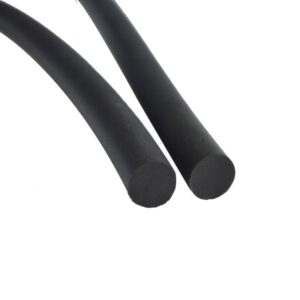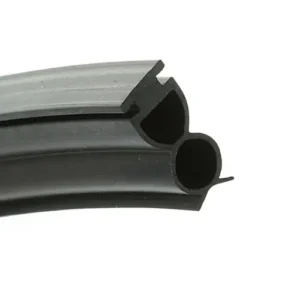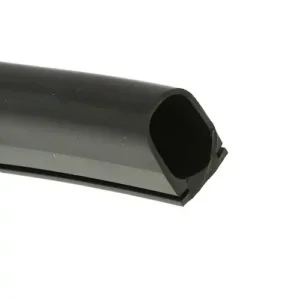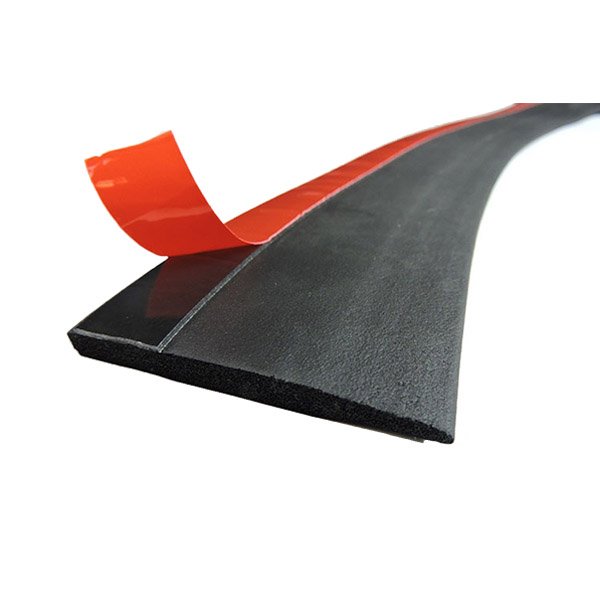Seal strips have many uses. People need to use it mainly for sealing and vibration-dampening applications. EPDM, neoprene, and SBR strips are common names here. Compared to these rubber strips, neoprene strips come ahead because of some benefits. This article mainly talks about those benefits. Ultimately, you will realize why you should choose neoprene rubber for your job.
Overview of Neoprene Strips
Neoprene is a famous type of synthetic rubber. Unlike natural rubber, neoprene offers a wide range of benefits. It has a polymerized chloroprene structure.
Neoprene tape is another name for neoprene strips. Seals, extrusion shapes, and gaskets are all part of strips. No matter what kind it is, the benefits come from how the material works.
Neoprene rubber is durable and resistant to oils, chemicals, and currents. As the title of this article implies, these strips have 12 crucial benefits. These benefits should be enough to make you choose neoprene strips.
Neoprene strips come in many types. First, a solid neoprene rubber strip offers high hardness. It is suitable for high wear and tear jobs and has excellent tensile strength. Second, neoprene foam strips provide good cushioning and dampening properties. These neoprene strips are prevalent for machines and equipment. Third, adhesive strips are the simplest to install. Other types are used in many applications as well.
12 Reasons Why You Should Use Neoprene Strips
There are several reasons why you should choose neoprene rubber for your project. As you already know, what are neoprene strips, and what are their typical properties? Well, neoprene weather strippings are trendy because of their benefits. This popularity makes this product suitable for many industrial and commercial needs. In this section, we will discuss why neoprene rubber is better.

Reason #1 Tough & Durable
Neoprene weather stripping is known for its toughness and durability. Its tensile strength generally ranges from 6.8MPa to 24MPa. Solid neoprene rubber is specially made for toughness. They may be used in dual durometer rubber with solid and sponge parts.
When you look at the different kinds of rubber, EPDM has 17MPa, and nitrile has 21MPa. Solid neoprene rubber strips are more robust. However, this rubber has good tear and compression resistance. In addition, they are very resistant to wear and weather. All these properties make neoprene weather stripping effective for a long time.

Reason #2 Chemical Resistant
One of the main reasons you should use neoprene strips is that they can stand up to chemicals. For petroleum-based chemicals, you can safely use these strips. Besides, they are also resistant to other oils, solvents, and mild chemicals. This ability reasonably makes neoprene sealing strips ideal for industrial and manufacturing settings.
On the other hand, it’s also important to know that some chemicals can break down neoprene. Acetone and heat weaken this rubber’s tensile strength. Be cautious with harsh chemicals and heat. If you know these limitations, you can ensure the effective use of neoprene rubbers.

Reason #3 Waterproof
Neoprene strips are also waterproof. It means they don’t absorb water. Therefore, they are perfect for use when they need to resist water.
Neoprene rubber usually has a closed-cell makeup. Because of how it is made, neoprene rubber is the best for use in the water. Boats, kayaks, and other vessels often use neoprene weather stripping.
Neoprene rubber is also widely popular for outdoor use. They do a great job of keeping out rain and wetness. For instance, you need neoprene weather protection for your car. It keeps the inside of your car nice and dry.
Moreover, it can be used in your home, garage, office, and industrial settings.
Reason #4 UV-Resistant
UV rays from sunlight may damage many materials, including rubber. However, not all rubbers are the same. Neoprene rubber can naturally resist UV. Therefore, they can withstand prolonged exposure to sunlight without degrading. Because of this, they are an excellent choice for outdoor applications.
Neoprene strips never crack, fade, or lose elasticity when exposed to UV. This ability to resist UV generally extends the lifespan of neoprene seals. Many outdoor uses, like kennels, hutches, and roofing, use neoprene rubber. Boats, cars, and airplanes also use neoprene rubber to resist UV.
Reason #5 Temperature Tolerance (-29°C to 121°C)
Neoprene sealing strips can withstand temperatures from -29 to 121 degrees Celsius. This favorable range is typically suitable for most applications. You can use neoprene rubber for both low and high-heat jobs.
EPDM rubber has a temperature range of 50°C to 120°C, while nitrile ranges from -35 to 120. Silicone rubber, on the other hand, withstands temperatures from -60 to 230. Clearly, silicone rubber is the best choice for high-heat jobs. However, neoprene is always a good option for moderate-temperature jobs.
Reason #6 Electrical Insulation and Fire Resistance
Neoprene strips are excellent electrical insulators. Note that neoprene has excellent static-resistance ability. As a result, neoprene rubber can withstand high voltages. You may often find its use in power transformers and many electrical circuits.
Moreover, neoprene rubber is also fire-resistant. However, nitrile or SBR rubber is the best for fire resistance. Neoprene rubber does a good job, but this is not very often.
Overall, neoprene sealing strips are a safe and efficient solution. It is safe for both electric and fire-involved jobs.
Reason #7 Vibration Dampening
Neoprene strips work great for reducing vibrations. Nevertheless, neoprene foam strips work best in this setting. They effectively absorb and reduce vibrations. Because of this, you may often find its use in machines and equipment. As you know, vibrations are typically not appropriate for machines. It affects the performance of the machine. Therefore, vibration dampening is crucial here.
A Solid neoprene rubber strip may not be suitable. It is not flexible like neoprene foam strips. Therefore, always choose neoprene foam strips for dampening. But you must check the other aspects as well. For example, neoprene foam is unsuitable at temperatures above 70 degrees.
Reason #8 Wide Range of Durometer Value
Neoprene rubber strips may have a wide range of durometer values. You can also find dual-durometer neoprene rubber strips.
A durometer scale typically measures the hardness of rubber. Neoprene can be soft, medium, or hard. Soft neoprene is ideal for cushioning and sealing. Medium neoprene is excellent for gaskets and insulation. Finally, hard neoprene is perfect for heavy-duty uses. The hardness ranges from 20 to 90 Shore A. They can be elongated from 100% to 800%.

Reason #9 Ability to Customize & Wide Color Options
Neoprene rubber typically allows you to make anything you want. From profiles to flat gaskets, you can give neoprene rubber any shape. Based on these options, there are many types of neoprene rubber strips.
Neoprene rubber strips with adhesive backing are easy to install and replace. The extrusion profiles are great for weather stripping. Next, neoprene tape can dampen or cushion vibrations.
Moreover, there are other types as well. People use neoprene rubber trim for edge protection. Then, neoprene rubber bumpers are for impact absorption. Neoprene rubber tubes are used for insulation and fluid transfer.
You can now realize that neoprene rubber offers various customizing options. So, based on your project requirements, you can create unique shapes and features.
Reason #10 Easy to Handle
Neoprene rubber is lightweight and flexible. It is easy to cut and shape, and you don’t need additional tools to work with it. Neoprene adhesive strips are especially easy to handle. Remove the old rubber strip, measure the length, and cut it. Then, clean the surface for better adhesion. Finally, install the neoprene strip at the correct location.
Again, handling neoprene rubber doesn’t create dust or splinters, so it is safe and hassle-free. Because of this, it is suitable for DIY projects and professional use. Moreover, you can roll or fold neoprene rubber, making it easy to store.
Reason #11 Long Lasting
You now know what a neoprene strip can offer from the above ten reasons. They are excellent for wear, tear, and impact resistance. Besides, they have wider temperature and pressure ranges. All these properties ensure that neoprene rubber can handle many situations. So, it proves that these rubber tapes are durable.
Reason #12 Cost-effective Solution
Neoprene rubber tapes are affordable. According to recent market prices, neoprene tape costs around $12 (1″x 1/8″ x 10′ long). EPDM tape costs around $17, and nitrile tape costs around $16.
From the previous point, you know neoprene strips are durable. It means you don’t need frequent replacements. This benefit reduces the costs and makes it a cost-effective solution.
Summary
Neoprene strips are prevalent and come in many styles. Solid neoprene rubber strips, for instance, are very resistant to wear and tear. They also have an excellent tensile strength. Conversely, neoprene foam strips work well to reduce vibrations.
There are 12 reasons why you should choose neoprene strips for your job. They are mainly famous for their chemical resistance, waterproofing, durability, and ease of use. Therefore, they are primarily used in the chemical, automotive, and aerospace industries.
Contact us for more information.
